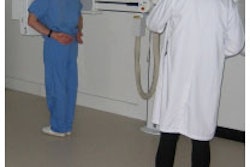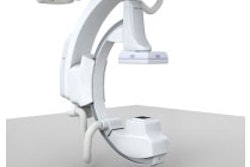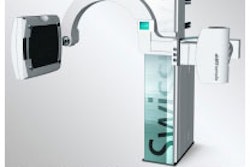New heart studies are shedding light on some enduring mysteries in the diagnosis of coronary artery disease in women.
What seems clear from the studies published on Tuesday is that angiography and conventional stress testing are insufficient to diagnose cardiovascular disease in women presenting with chest pain -- which may explain why the diagnostic rates for significant cardiovascular disease are lower in women than men, while mortality is not.
Still unclear are the precise risk factors that define the at-risk female population, and the best way to diagnose them, although MRI and ultrasound may have unique abilities among imaging tests.
Gender disparities in the diagnosis and treatment of heart disease are well known in the literature. Women typically present symptoms that are different from those in men. They are less likely to be treated for heart disease than men, and they respond differently to therapy. In general, women report more acute than prodromal symptoms, and up to half presenting with acute myocardial infarction report no prior chest pain symptoms.
Moving forward, however, implications of studies, reviews, and editorials published January 31 in the Journal of the American College of Cardiology and Circulation are likely to result in doctors paying more attention to women's symptoms, as well as the role of inflammation in heart disease.
WISE conclusions
Investigators in the Women's Ischemia Syndrome Evaluation (WISE) study found that the majority of women with "clear" angiography who are not diagnosed will continue to have symptoms, a declining quality of life, and repeated hospitalizations and tests. The WISE study began in 1996 with sponsorship from the National Heart, Lung and Blood Institute of the National Institutes of Health in Bethesda, MD.
The study results released this week claim that as many as 3 million women in the U.S. each year with coronary artery disease have a type of disease, called coronary microvascular syndrome, in which plaque spreads evenly throughout the walls of the arteries, rather than collecting into large blockages. This pattern of plaque buildup often results in coronary angiograms that appear normal, and thus the women do not receive further diagnostic workup or treatment -- putting them at risk of a heart attack.
In a review article, WISE investigator Dr. Leslee Shaw and colleagues noted that a majority of women without obstructive CAD at angiography "continue to have symptoms that contribute to a poor quality of life...."
When evaluated for symptoms suggestive of myocardial ischemia, women have lower rates of obstructive CAD at angiography, they noted. The idea was suggested by Diamond et al nearly two decades ago. They found that typical exertional angina in a 55-year-old man has an approximate 90% predictive capability in a man, compared with 55% to 90% in a woman of the same age. WISE data showed that the predictive value is particularly poor in diabetic patients and those with atypical angina or nonangina.
As for gender differences in atherosclerotic disease burden, Dr. C. Noel Bairey Merz and colleagues noted that although the prevalence of atherosclerosis indicators on imaging lags behind that of men, there is "evidence that the combination of smaller arterial size, potentially more prominent positive remodeling, and a greater role of the microvasculature (as noted by intimamedial thickness, retinal artery narrowing, or coronary calcification) carry a greater prognostic weight in women as compared with men.... For example, any given extent of coronary calcification using the Agatston score is associated with worsening mortality in women as compared with men (JACC, January 31, 2006, Vol. 47:3, Suppl. S, pp. S21-S29S).
Other imaging modalities' potential
In women at risk, cardiovascular MR may provide unique clinical utility for the "evaluation of subendocardial ischemia, improved precision for the assessment of left ventricular function and mass, and a detailed anatomic evaluation of both the myocardium as well as the ... peripheral vasculature," Shaw and colleagues wrote in their discussion of WISE data. In addition, they noted that MR spectroscopy can detect alterations in myocardial metabolism with changes in high-energy phosphates, providing a direct assessment of metabolic myocardial ischemia.
As for ultrasound, large artery structure appears differently in women, inasmuch as their coronary arteries are smaller than men independent of body size, Dr. Carl Pepine et al noted in their review. Sex hormones are known to play a factor in artery size as well. "Brachial artery size, readily measured noninvasively by ultrasound, may be helpful to identify women with early atherosclerosis," they wrote.
Stable angina
In the Circulation study, investigators from the Euro Heart Survey looked at more than 3,000 patients to determine how gender affects the diagnosis and management of stable angina. This particular type of coronary disease is more common in women, but is less likely to be thoroughly diagnosed, even with a full imaging arsenal at hand, according to lead researcher Dr. Caroline Daly from the Royal Brompton and Harefield NHS Trust in London.
For this study, data was culled from 197 centers across Europe, including France, Italy, and Spain, between March and December 2002. Baseline data consisted of information collected during the first four weeks that the patient was seen by clinicians.
In addition to ECG and exercise testing, other imaging variables included in the analysis were stress echocardiography, myocardial perfusion scanning, and coronary angiography.
A total of 3,779 patients were included with women representing 42% of that group. The majority of subjects (88%) had moderate to mild angina (Canadian Cardiovascular Society classes I or II). Women tended to present with more class II symptoms.
According to the results, 73% of the women in the study underwent exercise ECG compared with 78% of the men. Coronary angiography was performed in 31% of women versus 49% of men. There was less disparity for stress echocardiogram (4% of women and 4% men had this test) and stress perfusion imaging (15% of women and 13% of men). Still, the use of stress imaging techniques in women was not frequent enough to be significant, the authors stated.
In terms of exam results, a higher proportion of women had negative or inconclusive ECG results. Nevertheless, 41% tested positive for inducible ischemia on perfusion scintigraphy while 57% had positive inducible ischemia results on stress echocardiography.
For those patients with positive exercise ECG results, 56% of women went on to an angiographic exam compared with 65% of men.
"It may be argued that women are not referred for stress testing because of the high false positives, but in this survey only a quarter who did not receive an exercise ECG went on to have an alternative stress imaging technique," the authors stated (Circulation: Journal of the American Heart Association, January 31, 2006, Vol. 113:4, pp. 490-498).
In total, 79% of all patients were found to have significant coronary disease, with 63% of this group made up of women. Women also had more single-vessel disease, Daly's group stated.
Of course, imaging results can affect how the patients are treated. As with diagnosis, women tended to be undertreated, including being less likely to undergo revascularization or receive antiplatelet therapy, the authors wrote.
At the end of the follow-up period, 2% of the women in the study died as had 1.4% of the men. Women with confirmed coronary artery disease were less likely to have completely successful treatment of angina and more likely to suffer death or myocardial infarction during the 13-month follow-up period, Daly's group pointed out.
"In agreement with previous findings ... gender was a significant predictor of the use of coronary angiography as part of the initial investigation of stable angina," they concluded. "Women were 40% to 50% less likely to have an angiogram." This held true across all the geographic regions and cardiology centers that participated in this study.
The authors recommended that exercise testing should remain the first investigative tool for angina in all patients. Depending on those results, cardiologists should consider referring female patients for additional testing, especially because the prognosis is significantly worse for women with angina and confirmed coronary disease.
By Brian Casey
AuntMinnie.com staff writer
February 2, 2006
With additional reporting by AuntMinnie.com staff writer Shalmali Pal.
Related Reading
Traditional risk factors may fail to identify women with atherosclerosis, December 19, 2005
Heart disease spotted, treated too little in women, September 2, 2005
Hypertrophic cardiomyopathy seems underrecognized in women, August 29, 2005
Canadian cardiologists define low risk for women with chest pain, May 30, 2005
Echocardiography bests treadmill test for diagnosis of CAD in women, June 14, 2000
Copyright © 2006 AuntMinnie.com



















